Health
Desired Outcomes
All people have the opportunity to enjoy long and healthy lives. Avoidable deaths, disease and injuries are prevented. All people have the ability to function, participate, and live independently or appropriately supported in society.
Introduction
Good health is critical to wellbeing. Without it, people are less able to enjoy their lives to the fullest extent, their options are limited, and their general levels of contentment and happiness are likely to be reduced.
Good health has two core dimensions: how long people live and the quality of their lives. The desired outcomes recognise both aspects. As well as enjoying long lives, people want to be free from the pain, suffering and incapacity that injury and illness bring.
The desired outcomes also acknowledge that not all people can live fully independent lives. For some, illness or disability means they need support from families, government agencies or other networks. Providing this support is an important part of social wellbeing.
Good health includes both physical and mental health. Mental illness is generally associated with a state of reduced wellbeing and contentment, and mental health problems can also prevent people from participating fully in society.
Injury and illness inhibit people's ability to participate in education, training and employment, leading to reduced economic standards of living. They can also reduce people's ability to participate in other areas of life, such as family life, socialising with friends, joining community activities and taking part in recreation and leisure pursuits, leading to feelings of frustration and isolation.
A range of factors affect health outcomes, including genetic predisposition, behaviour, the physical and social environment and the availability of health services. Increasing attention is being paid to the role of socio-economic factors in influencing health. People with low incomes, poor housing and few qualifications are likely to have disproportionately poorer health.5
Indicators
Six indicators are used in this chapter. Taken together, they provide an overall picture of the state of the nation's health now and the likely trends in the future. They cover both the length and quality of life, and include both physical and mental health. The indicators are: independent life expectancy, life expectancy at birth, dependent disability, suicide, cigarette smoking and obesity.
The first four indicators are relevant to the current state of the nation's health. Together, they directly measure the desired outcomes relating to long and healthy lives, and people's ability to participate in society. The last two indicators are strong predictors of future health outcomes.
Independent life expectancy refers to the number of years a person can expect to live independently, ie free of disability needing assistance from another person or from a complex assistive device. This is a summary measure of population health integrating both the length of life (life expectancy) and the quality of life (dependent disability) dimensions of health.
The next two indicators measure each dimension of health separately. Life expectancy at birth measures the survival experience of the population: how long people live. It is an indicator of fatal health outcomes and of health related quality of life. Dependent disability measures non-fatal health outcomes.
The suicide rate serves as a proxy for mental health outcomes, as these are not captured separately within the dependent disability indicator. Though the indicator covers the suicide rate for society as a whole, it includes details of youth suicide rates. New Zealand's youth suicide rates are high by international standards and youth suicide prevention is an important policy priority.
The last two indicators are strong predictors of future health outcomes. The links between cigarette smoking and poor health are widely recognised. For example, cigarette smoking (active and passive) is a risk factor for many cancers, respiratory, and cardiovascular diseases, and has been linked with low birth weight, Sudden Infant Death Syndrome, and other adverse child health outcomes. Obesity is linked with poor health outcomes, such as increased risk of heart attacks, strokes, type 2 diabetes, and some cancers6. It is also linked to poor outcomes in other outcome domains including poorer employment outcomes, lower incomes, and reduced social participation.
Independent life expectancy
Definition: The number of years a person could expect to live independently, ie without any functional limitation (disability) requiring the assistance of another person or complex assistance device.
Relevance: Independent life expectancy (ILE) is a summary measure of population health that captures both the 'quantity' and 'quality' of life dimensions of health. It is a positive measure, capturing expectations of life free from disability requiring assistance (dependence). Improvements in independent life expectancy reflect changes in social and economic conditions, lifestyle changes, medical advances and better access to health services.
Current Level and Trends
Provisional data for 2001 shows that males had an independent life expectancy at birth of 64.6 years. The figure for females was 68.4 years, a difference of 3.8 years. Independent life expectancy at birth has improved for females since 1996 but not for males (64.6 years for males and 67.4 years for females). This has resulted in an increase of one year in the sex gap in independent life expectancy at birth.
Figure H1.1
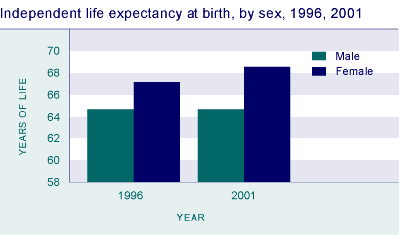
Source: Ministry of Health,
revised data for 1996, provisional data for 2001
Ethnic Differences
Only partial (0-85 years) independent life expectancy can be estimated for ethnic comparisons because of the small number of Māori aged over 85 years. These ethnic-specific statistics are not comparable with those for the total population.
There are large differences between Māori and non-Māori in their probability of living a long and healthy life. Provisional estimates for 2001 indicate a newborn Māori male had a partial (0-85 years) independent life expectancy of 57.5 years, compared to 65.0 years for a non-Māori male, a gap of 7.5 years. The difference is greater for females: a Māori female born in 2001 could expect to have a partial independent life expectancy 9.5 years less than her non-Māori counterpart (58.6 years, compared to 68.1 years for non-Māori females).
Between 1996 and 2001, partial (0-85 years) independent life expectancy improved for Māori males and non-Māori females, but declined slightly for non-Māori males and Māori females.
Figure H1.2
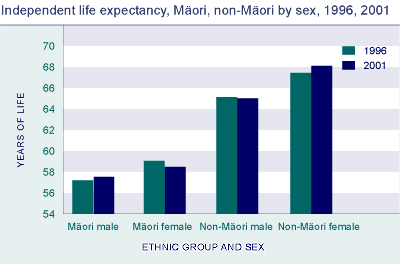
Source: Ministry of Health,
revised data for 1996, provisional data for 2001
Note: These Māori, non-Māori comparisons in independent life expectancy
are based on estimates for the 0-85 year age group because of the small
number of Māori over 85 years of age
International Comparisons
In June 2000, the World Health Organisation (WHO) introduced a new health expectancy measure, now called 'healthy life expectancy' (HLE). Unlike ILE, which uses a single disability threshold, HLE uses a continuous scale that includes all levels of disability. The necessary health state valuations required to construct this measure are not yet available for New Zealand . When these become available, the Ministry of Health intends to replace the ILE indicator with HLE.
Life expectancy at birth
Definition: Life expectancy at birth indicates the total number of years a newborn could expect to live, based on the mortality rates of the population at each age in a given year.
Relevance: Life expectancy at birth is a key summary indicator of fatal health outcomes, ie the survival experience of the population.
Current Level and Trends
In the period 1999-2001, life expectancy at birth was 76.0 years for males and 80.9 years for females. Since the mid-1980s, gains in longevity have been greater for males than for females. Between 1985-1987 and 1999-2001, life expectancy at birth increased by 4.9 years for males and 3.8 years for females.
With the decline in the infant mortality rate (from 11.2 deaths per 1,000 live births in 1986 to 5.3 per 1,000 in 2001), the impact of infant death on life expectancy has fallen. The gains in life expectancy over the last two decades can be attributed mainly to reduced mortality in the older age groups (50 years and over). Reduced mortality rates are due to generational effects, better living standards, and improved public and personal health care.
Figure H2.1
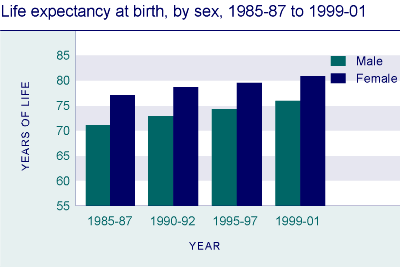
Source: Statistics New
Zealand 2003a, Table 4.12
Ethnic Differences
There are marked differences in life expectancy across ethnic groups. There has been a steady increase in life expectancy for non-Māori, non-Pacific people, particularly males. Their life expectancy at birth has increased from 71.9 years in 1985-1989 to 75.7 years in 1996-1999 (a gain of 3.8 years). For non-Māori, non-Pacific females, life expectancy at birth has increased from 77.9 years to 80.8 years (up 2.9 years).
Over the same period, there was much less improvement in life expectancy for Māori. For Māori males, there was a gain of just under one year (from 64.9 years to 65.8 years), and for Māori females a gain of just six months (from 70.5 years to 71 years). The gap in male life expectancy at birth between non-Māori, non-Pacific and Māori ethnic groups increased from seven years in 1985-1989 to 9.9 years in 1996-1999. The corresponding gap for females increased from 7.4 years to 9.8 years.
For Pacific people, life expectancy at birth over the same period has increased by one year, from 66.9 years to 67.9 years for males, and from 73.2 years to 74.2 years for females.
Figure H2.2
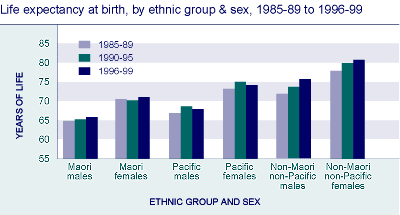
Source: Ministry of Health
(forthcoming), table 25
Note: 1. Māori and Pacific peoples mortality rates are corrected for
undercount by record linkage
2. Ethnicity data is based on the prioritised concept of ethnicity
Socio-Economic Differences
There is a strong association between life expectancy and the level of deprivation in the area where people live. In 1998-2000, males in the least deprived 10th of small areas in New Zealand could expect to live 9.5 years longer than males in the most deprived 10th of small areas (meshblocks with median populations of at least 90 people). For females, the difference was smaller, but still substantial, at 5.6 years. These figures clearly illustrate the links between socio-economic status and health.7
International Comparison
Since the 1960s, longevity has improved faster in other countries than in New Zealand . Although there was some improvement in the 1990s, life expectancy in New Zealand remains lower than that of Japan, Sweden, Australia and Canada, but higher than the United Kingdom and the United States. The latest available data (for 1999) shows that New Zealand males are ranked seventh out of 28 OECD countries and New Zealand females are ranked 13th equal.8
Dependent disability
Definition: The proportion of the population who acknowledge one or more functional limitations and require assistance, either intermittently or on a daily basis.
Relevance: The disability prevalence rate is an important summary measure of non-fatal health outcomes.
Current Level and Trends
In 2001, the dependent disability prevalence rate was 10.2 percent for males and 9.3 percent for females. The rate has barely changed since 1996-1997, when it was 9.7 percent for males and 9.9 percent for females.
Figure H3.1
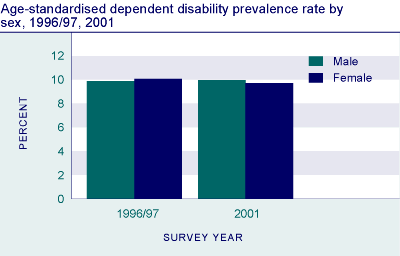
Source: Ministry of Health
Note: Age-standardised to the WHO world population
Most people who have disabilities requiring assistance need only intermittent help. In 2001, 7.8 percent of males and 7.0 percent of females had this moderate level of dependent disability. A further 2.4 percent of males and 2.3 percent of females had a more severe level of dependent disability, requiring daily help.
Sex Differences
Since women are predominant in the older age groups where dependent disability is most common, they make up the majority of people with functional disabilities requiring assistance. However, when the different age distributions of males and females are taken into account, sex differences in dependent disability prevalence rates are minimal. Males are slightly more likely than females to have a moderate functional disability, requiring intermittent assistance from others.
Ethnic Differences
Māori are more likely than non-Māori to have a functional disability requiring assistance. This difference is consistent with higher rates of chronic illness and injury experienced by Māori across most age groups. In 2001, the dependent disability prevalence rate was 13.4 percent for Māori males and 14.5 percent for Māori females. There was almost no change in dependent disability rates for Māori from 1996-1997 to 2001.
In 2001, Māori were about twice as likely as non-Māori to have a severe functional disability requiring continuous or daily care. However, the small numbers of Māori at older ages, where levels of severe disability are highest, mean these figures should be regarded with caution.
Table H3.1 Age-standardised dependent disability prevalence rate (%), Māori, non-Māori, by level of functional disability, 2001
| Moderate | Severe | Total | |
|---|---|---|---|
| Māori Males | 9.4 | 4.0 | 13.4 |
| Māori Females | 9.9 | 4.6 | 14.5 |
| Non-Māori Males | 7.6 | 2.3 | 9.9 |
| Non-Māori Females | 6.8 | 2.2 | 9.0 |
| Total Males | 7.8 | 2.4 | 10.2 |
| Total Females | 7.0 | 2.3 | 9.3 |
Source: Ministry of Health |
|||
International comparison
The rate of dependent disability in New Zealand appears to be higher than that reported in similar studies in Australia, Canada and the United States, although this may be influenced by differences in the collection and classification of data.9
Suicide
Definition: The number of suicide deaths per 100,000 population.
Relevance: Suicide is an indicator of mental health in the population and a leading cause of death among younger adults. The New Zealand health strategy has identified reducing the rate of suicides and suicide attempts as one of its priority population health objectives.10
Current Level and Trends
In 2000, 458 people died by suicide, down from 516 in 1999. The age-standardised11 suicide death rate was 11.2 per 100,000, compared with 12.6 per 100,000 in 1999. The suicide death rate increased during the period 1992-1998 but has declined since 1998 to a point just below the 1986 rate of 11.5 per 100,000.
Figure H41
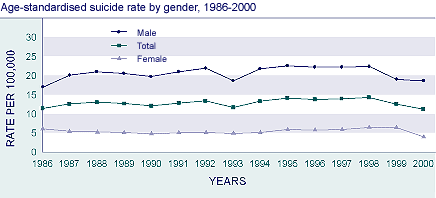
Source: Ministry of Health, New
Zealand Health Information Service
Note: 1999 and 2000 figures are provisional. Age-standardised to Segi's
world population
Sex Differences
Males have a much higher rate of death by suicide than females, with 18.7 deaths per 100,000 males in 2000, compared with 4.0 per 100,000 females. The difference is associated with choice of methods12. The male suicide rate has declined since 1998, while the female rate increased slightly during 1996-1999 but fell in 2000. Because of the small numbers involved, it is more reliable to consider the trend over several years.
While males account for most suicide deaths (82 percent in 2000), females account for the majority of recorded suicide attempts that do not result in death (64 percent in 2000/2001).
Figure H4.2
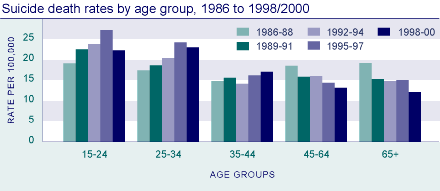
Source: Ministry of Health, New
Zealand Health Information Service
Note: 1. Three-year average rates for 10-year age groups calculated by
Ministry of Social Development
2. 1999 and 2000 figures are provisional
Age Differences
In 2000, the 25-34 year age group had the highest rate of suicide death (22.8 per 100,000, or 126 deaths), followed by the 15-24 year age group (18.1 per 100,000, with 96 deaths). During the late 1980s and 1990s, the rate of suicide was consistently highest at ages 15-24 years and peaked in 1995, when there were 156 deaths (a rate of 28.7 per 100,000). The youth suicide death rate has fallen since 1998 and was lower in 2000 than it had been in 1990. In contrast, suicide rates for 25-34 year olds are now considerably higher than they were a decade ago. Suicide rates have been falling among people over 45 years. At ages 65 and over, they have fallen from among the highest suicide rates in 1986-1988 to the lowest for any age group in 1998-2000.
Ethnic Differences
In 2000, there were 80 Māori deaths from suicide, accounting for 17 percent of all suicides in that year. The age-standardised rate of suicide death was 13.1 per 100,000 for Māori, compared to 10.7 for non-Māori. The suicide rate for Māori youth in 2000 was 25.7 per 100,000, compared with the non-Māori rate of 16.2 per 100,000. The number and rate of Māori suicide deaths have dropped for both Māori and non-Māori since 1996. Because of small numbers, trends in Māori suicide rates should be treated with caution.
Table H4.1 Age-standardised suicide rates and number of suicide deaths, Māori and non-Māori, 1996-2000
| Year | Age-standardised rate per 100,000 | Number | ||
|---|---|---|---|---|
Māori |
Non-Māori |
Māori |
Non-Māori |
|
| 1996 | 17.5 | 12.9 | 95 | 445 |
| 1997 | 17.5 | 13.1 | 103 | 458 |
| 1998 | 19.2 | 13.1 | 112 | 465 |
| 1999 | 12.1 | 12.2 | 78 | 438 |
| 2000 | 13.1 | 10.7 | 80 | 378 |
Source: Ministry of Health;
New Zealand Health Information Service |
||||
International comparison
A comparison of suicide rates in selected OECD countries for the years 1997-2000 shows that New Zealand has the fourth highest suicide rate among males (equal with Australia), while the female rate is among the lowest (10th out of 12 countries). New Zealand is one of a small number of countries which have higher suicide rates at the younger ages. For youth suicide rates in the same OECD countries, New Zealand is ranked second (after Finland) among males and fourth (after Norway, Japan and Finland) among females.
Prevalence of cigarette smoking
Definition: The proportion of the population aged 15 and over who currently smoke cigarettes.
Rationale: Tobacco smoking is a well-recognised risk factor for many cancers and respiratory and cardiovascular diseases. In addition, exposure to environmental tobacco smoke (particularly maternal smoking) has been identified as a major risk factor for Sudden Infant Death Syndrome (SIDS) and respiratory problems in children. Internationally, smoking has been identified as the major cause of preventable death in OECD countries.13
Current Level and Trends
In 2001, 25 percent of New Zealanders aged 15 years and over were cigarette smokers. The prevalence of smoking has declined from 30 percent in 1986 with most of the decline occurring between 1987 and 1991.
Figure H5.1
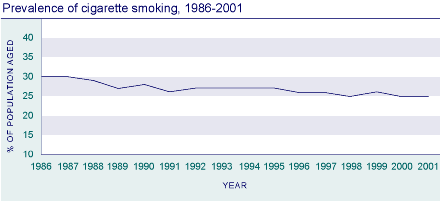
Source: Ministry of Health 2002b,
Table 5
Age and Sex Differences
Smoking is most prevalent among people aged 25-34 years, followed by those aged 15-24 years, and people aged 35-54. Older people aged 55 and over are much less likely to smoke and have experienced the greatest decline in smoking prevalence over the past 15 years.
Whereas in 1986 women were slightly more likely to smoke than men (31 and 29 percent respectively), smoking prevalence was the same for both sexes in 2001 (25 percent) and has been similar over the past decade. Females are slightly more likely than males to smoke at ages 15-34, but for those aged 35 and over, smoking has generally been more prevalent among males, with both sexes becoming less likely to smoke over the 1990s.
Table H5.1 Prevalence of smoking by sex and age group, 2001
| Percentage in each age group who smoke cigarettes | |||||
|---|---|---|---|---|---|
| 15-24 | 25-34 | 35-54 | 55+ | Total | |
| Male | 30.9 | 32.6 | 25.9 | 13.4 | 25.1 |
| Female | 32.4 | 34.0 | 25.1 | 13.2 | 24.8 |
Source: Ministry of Health Tobacco Facts May 2002, Appendix 3, Table 1 |
|||||
Ethnic Differences
Smoking prevalence among Māori has remained relatively unchanged over the 1990s. Māori women have the highest smoking prevalence (51.4 percent), followed by Māori men (44 percent). Among Pacific peoples, smoking is much more prevalent among men (36.1 percent), than among women (23.8 percent). Smoking is also more prevalent among those with lower incomes, beneficiaries, and those living in the most deprived areas.
Table H5.2 Age-standardised prevalence of smoking by sex and ethnicity, 2001
| Percentage in each ethnic group who smoke cigarettes | ||||
|---|---|---|---|---|
| Māori | Pacific peoples | European/Other | Total | |
| Male | 44.0 | 36.1 | 24.2 | 26.8 |
| Female | 51.4 | 23.8 | 23.8 | 27.4 |
| Total | 48.6 | 28.9 | 23.9 | 27.1 |
Source: Ministry of Health
Tobacco Facts May 2002 Table 1 |
||||
Socio-Economic Differences
The proportion of smokers is related to the level of deprivation in an area. An analysis of 1996 census data shows that the proportion of smokers in the most deprived (decile 10) areas is two to three times the proportion of smokers in the least deprived (decile 1) areas for all age groups, and for both men and women.14
International comparison
In the late 1990s New Zealand males had the second lowest smoking prevalence rate of 28 OECD countries (after Sweden, 17 percent) while females were ranked 13th. New Zealand is among those countries with little sex difference in smoking rates. In some of the countries with lower female rates than New Zealand, there is a large sex difference in smoking prevalence. For example in Japan, 53 percent of men smoked compared with 13 percent of women.
Obesity
Definition: The proportion of the population aged 15 and over who are obese. Obesity is defined as having a Body Mass Index (BMI) greater than 30 for New Zealand European/Other, or greater than 32 for Māori and Pacific people.15
Rationale: Obesity is associated with heart disease, diabetes, stroke, high blood pressure and some cancers. The increase in the prevalence of obesity has been identified as a major cause of the projected increase in diabetes.16
Current Level and Trends
In 1997, 17 percent of adults aged 15 and over were obese (15 percent of males and 19 percent of females).
In New Zealand, obesity is becoming increasingly common, with a 50 percent increase in adult obesity in the last decade. In 1989-1990, obesity was found in 10 percent of males and 13 percent of females.
Internationally, increasing levels of obesity are related to social changes, including shifts towards less physically demanding work, increased used of automated transport, labour saving technology in the home, and passive leisure. At the same time, it has become easier to access diets high in fat and energy.
Figure H6.1
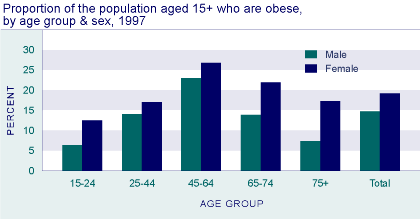
Source: Ministry of Health 1999d
Age and Sex Differences
Obesity increases with age, peaking at the 45-64 year age group (23 percent for males, 27 percent for females), then declining at the older age groups. Females are more likely to be obese at all ages. The sex difference in obesity is greatest at ages 65 years and over.
Ethnic Differences
Māori and Pacific people have higher rates of obesity than other ethnic groups. In 1997, 27 percent of Māori males and 28 percent of Māori females were obese, For Pacific people, the figures were 26 percent for males and 47 percent for females. This compares to 12.6 percent for European/Other males and 16.7 percent for European/Other females.
Figure H6.2
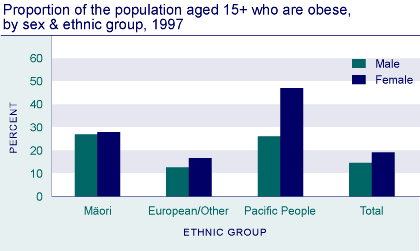
Source: Ministry of Health 1999b
Socio-Economic Differences
For females, there is a strong relationship between obesity and the level of deprivation in the area where people live. Females living in the least deprived quartile of small areas in New Zealand had the lowest level of obesity (13.1 percent), while those in the most deprived quartile had the highest level (25.4 percent). This relationship was not evident for males.17
International comparison
New Zealand has a relatively high rate of obesity compared with other OECD countries. In the late 1990s New Zealand was ranked fourth out of 15 countries in the rate of obesity in the adult population. The highest rates of obesity are in the United States (26.0 percent), the United Kingdom (21.6 percent) and Australia (20.8 percent).18
